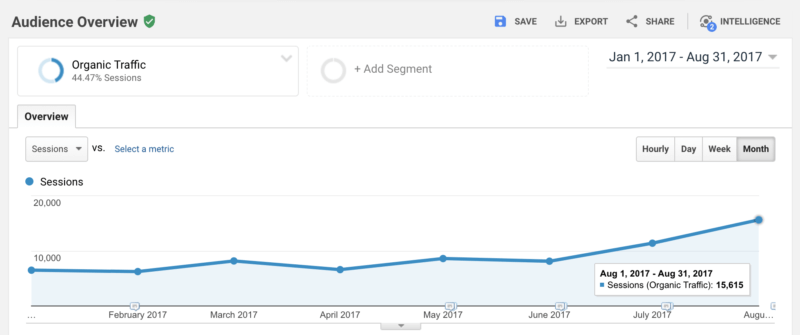

Traditional PR vs SEO for B2B Companies
Traditional PR vs SEO for B2B Companies https://sembyotic.com/wp-content/uploads/PR-vs-SEO-boxing-1024x593.png 1024 593 Adam Koontz Adam Koontz https://secure.gravatar.com/avatar/cdabc72036e4b722e8810040aab02661?s=96&d=mm&r=g- Adam Koontz
- no comments
The title of this article is somewhat misleading. If you’re considering either SEO or traditional PR, chances are that your fundamental goal is to gain exposure for your business. In today’s digital world, the two really work together. Traditional PR done right can have a profound impact on your site’s SEO, and SEO can influence your brand’s awareness which impacts the reach of your traditional PR efforts.
I’ve been managing tech B2B websites long enough to have seen first-hand how traffic patterns often look after a press announcement. If the below image looks familiar, take solace in the fact that you’re not alone.


A common traffic pattern for B2B websites after a press release.
Some sort of a spike in visits within the first few days after the release is to be expected, but wouldn’t it be nice if the average level of visits were to return to a higher plateau?
The Benefits of Sustained Organic Search Growth
The biggest difference between typical traffic patterns for PR vs a sustained SEO program is the steady rise in organic search traffic over time. If you look at the chart below, you’ll see the graph trending up and to the right, bringing more and more daily website visitors as time goes by.


Organic SEO provides steady, sustained traffic growth to your website.
There are also a few more benefits to a sustained organic SEO program that you should consider:
- Your Domain Authority (a measure of how trusted your domain is on Google) will improve, making it easier for new and future content to rank more quickly.
- Your rankings (and traffic) will likely rise even for existing content.
It’s not uncommon for sites that have invested in organic SEO to see almost immediate rankings for brand new content due to their higher Domain Authority.
Outreach: A Shared Effort Between PR and SEO
To this day, one of the most important things you can do to boost your organic SEO is to acquire links back to your site from highly relevant and trusted domains (backlinks). The process of acquiring those links is where the real work lies, and it typically takes a combination of knowing what to look for along with some creative outreach messages that can land you a link as a win-win scenario between your business the publication or blog that links back to you.
The process for PR is similar and it’s highly likely that the individuals your PR firm is reaching out to for article placements are the very same individuals that your SEO firm would want to get backlinks from. However, the PR firm is often looking at things through the lens of “reach”, “impressions”, or “mentions”. Meanwhile the SEO firm is ultimately looking for new backlinks. One of the tactics we often leverage to seek new backlinks is to look at mentions of the brand from high Domain Authority websites that do NOT link back. From there, we’ll begin the effort of outreach attempting to turn the pre-existing mention into a backlink.
There’s a high chance that the PR firm already has the relationship with the editor or analyst the SEO firm would like to reach out to and they likely could have secured the backlink from the very beginning if it was on their radar. The “reach” they’re so excited to report on ultimately translates to the spike in traffic from the first chart shared above, but the backlinks could have translated into the sustained growth from the organic SEO chart.
The Goals Are the Same, but the Value is Disproportionate
Whether engaging in traditional PR or investing in SEO, your goal is probably to increase exposure for your business. Many B2B companies don’t consider digital marketing and SEO as part of improving their exposure. When they do, they often treat their PR efforts and SEO efforts separately. For the companies that have wisely chosen to do both, they tend to operate in silos without any knowledge of what the other is doing.
What I’ve observed is that the marketing department has a relatively sizable budget to retain a PR firm. Traditional PR, after all, has been a common part of B2B marketing for years and the fees associated with retaining a PR firm can be high but the value is rarely questioned.
Agility PR reported that in September of 2017, “The Edelman’s, Weber Shandwick’s and FleishmanHillard’s of the world don’t get out of bed for less than $25,000 and command fees of $100,000 or more per month.” Of course, that’s not the typical PR client, but with standard B2B budget ranges at or near $10,000 per month that’s still a significant investment. For smaller clients spending $5,000 a month or less, they can expect a more narrow focus of PR services (i.e. just local media pitching, solely trade media, etc.)
And more and more companies are relying heavily on public relations as a key marketing tactic. Statista reported,
“Among large companies (500+ employees) in the United States, 46 percent engaged in PR activities; 19 percent hired an external agency to handle them. Among small and medium sized enterprises, 31 percent invested marketing dollars in public relations, and 15 percent stated PR was the marketing tactic they relied on most to grow their business.”
SEO, on the other hand, is still catching on in the B2B world. The value and the effort are often misunderstood or under-appreciated and SEO firms seldom receive the resources and support required to do an adequate job. In cases where an SEO firm is engaged, they’re often limited to technical SEO and content adjustments. I’ve maintained that the value is arguably higher for SEO since it provides long-lasting benefits across more audiences (influencers, prospects, career-seekers, etc.). Plus, the value can remain present even after the ongoing investment is suspended.
Synergy Between SEO and PR Helps Broaden Reach and Builds Sustained Traffic
Incorporating SEO practices into traditional PR activities can have a profound impact on the exposure of your business. By working together, each can become more effective. Seeking quality backlinks to your businesses when you land those press mentions is another organic SEO tactic that now needs to be blended with PR to ensure best outcomes. Quality backlinks are instrumental in growing both a company’s brand awareness and site authority which also helps with search ranking.
Google’s algorithms continue to constantly evolve, improve, and are better able to understand and distinguish quality links and content versus a gaming of the system. Previous strategies such as heavy use of anchor text on internal links, certain directories, paid links, links in comments, multiple microsites, or creating separate domains no longer provide the boost they once did. Worst case, these strategies could lead to penalties from Google. The best backlinks come from relevant, high Domain Authority sites, and those are often one and the same as the coveted publications your PR firm is seeking coverage from. If you really want to boost the exposure for your business, it’s time to find ways to bring traditional PR and SEO together.
Adam Koontz
Adam is President of SEMbyotic, a digital marketing, web design, and SEO company based in San Jose, California. @adamkoontz
All stories by: Adam Koontz

Leave a Reply